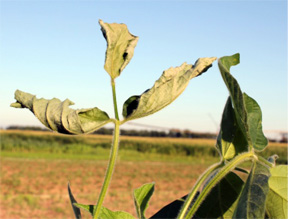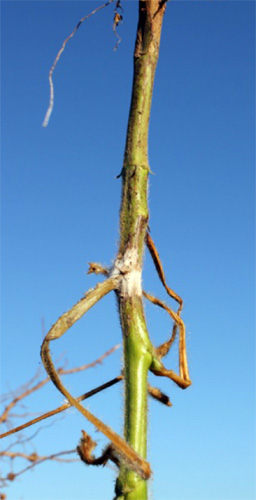White mold becoming evident in southwest Michigan irrigated soybean fields
The recent rains and cold front may have ended the blistering hot weather, but it brought with it the challenge of white mold in soybean fields.
|
Growing conditions have greatly improved following last weekend’s rainfall in the southwest corner of Michigan. While the rains and the subtle cold front brought an end to the 100 degree heat indexes in the area, it also might mean the beginning of another challenge – white mold.
White mold is caused by the fungal pathogen Sclerotinia sclerotiorum, so the disease is also called Sclerotinia stem rot. White mold fruiting bodies release spores into the plant canopy when saturated conditions exist in the soils for a period of time. The disease often begins to become evident as the plants are beginning to expend energy, filling the lower pods of the soybean plant. Infected plants will exhibit a wilting or dried leaf appearance at the top of the plant. Prolonged wet or moist conditions in the plant canopy help the pathogen to infect the plants. White mold spores infect the plants via the flower petals. White mold generally infects plants in heavy vegetative growth areas with low air flow. Soybean plant canopies are now approaching 36 to 40 inches in height on a lot of irrigated soybean fields. Drilled soybeans are usually the first fields to show the symptoms because the limited air flow allows the plants to stay saturated longer. Infected plants can quickly decline, causing the plants to lodge and stop the grain filling process. Heavily infected fields often have the odor of hay that has gotten wet in the field. Yield losses can reach 50 percent or more in heavily infected areas of fields.
|
White mold tends to build in fields over time. The overwintering bodies, called sclerotia, tend to persist in the soil until another susceptible crop is grown. In southwest Michigan, soybeans and snap beans are the most prevalent crop hosts. Fungicides are usually considered to be ineffective at controlling the severity of the disease once infection has occurred, and multiple applications are required to cover the whole infection period. Selection of tolerant varieties can help in managing white mold in soybean production.
While treatment of infected soybeans is a challenge, sanitation can be important to stop the spread of the disease within your fields. Consider harvesting the areas of your fields with white mold last. Then thoroughly clean the combine before you begin harvesting corn. Sclerotia can be spread from field to field via contaminated harvesters. MSU’s Department of Plant Pathology’s Jay Hao has been conducting field trials of a biological fungicide, Contans from SipcamAdvan. Hao is evaluating the effectiveness of Contans in reducing incidence and severity of white mold in heavily infected fields.
For more information on white mold, visit MSU plant pathologist Martin Chilvers’Field Crop Pathology website or read Chilvers’ article on Sclerotinia stem rot of soybean, identification, factors and management.
White mold and soybean sudden death syndrome will be discussed at length at the Southern Michigan Soybean Disease Center Field Day, which will be held Wednesday, August 24 near Decatur, Mich. For more information about this event, call the Van Buren County MSU Extension office at 269-657-8213.



 Print
Print Email
Email

